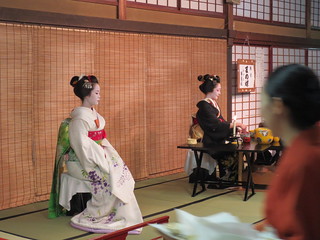The late afternoon, Monday 29th April 2013
We’d spent most of today in the Higashiyama region of Kyoto and had arrived at Gion in the late afternoon. I first read Memoirs of a Geisha in 2006 after finishing my university exams and loved it straight away. The bulk of the story centres around the Gion region of Kyoto, which is the best-known Geisha district in Japan. I never thought we’d be able to get tickets to a show – they are incredibly popular, and most Japanese who go book months in advance. However, Ben used the tried and true method of showing up on a whim and asking if any were available. As luck would have it, they were.
Geisha are highly skilled artists who train for years to become expert in traditional Japanese dance and song. The Kyoto geisha (or geiko as they are more accurately called) are not prostitutes, though the history of geisha has involved different nuances of what is expected of a women whose profession is to entertain. I like to think along the lines of how the lonely planet puts it; that they are ‘living museums.’
Geisha performances are held sporadically, the one we saw is held every spring to coincide with the blooming of the cherry blossoms (which we missed by about 2 weeks). It is known as Miyako Odori; “Dances of the Old Capital.” We also got tickets to the tea ceremony which preceded the performance. Sadly, we weren’t allowed to take pictures during the performance, so the only ones we have are of the tea ceremony.
The tea ceremony is very commercialised and I imagine a far cry from a real tea ceremony. But we enjoyed it nevertheless. We had arrived early, and saw that most Japanese dress up smartly for the performance, as we might for a night at the opera (honesty disclaimer – I’ve never been to an opera in the UK). A number of women were wearing traditional kimono, and we felt slightly awkward in our scruffy casuals that we’d been wearing to explore Kyoto. However, as more people began to arrive, we realised that we weren’t the only westerners to turn up in ‘normal’ clothes.
We were first taken inside to a waiting area (or rather, a holding pen) surrounded by stalls selling sweets and other souvenirs. Once the room had filled almost to capacity, we were ushered upstairs to a large room filled with long benches and low stools. We were seated and served a sweet (onto a painted plate that you can keep as a souvenir) as two geisha prepared tea on a stage at the front.
We Brits have our little rituals surrounding making a cuppa to our own personal taste, and making a brew is a way of getting to know someone. However, the Japanese tea ceremony is an art, and an artist needs tools. There are a number of implements used, and whilst we couldn’t see much from where we were sat, we did see that there was some delicate whisking involved.
The tea that was served is quite different from the green tea we were used to. It was much more bitter, and was thicker and frothier (because of the whisking). As soon as we had gulped it all down, we were shooed out to allow the next round of punters in – while we waited in another antechamber to take our seats in the theatre. At this point we managed to get hold of a programme, which explained the story behind the 8 scenes that were to be performed (I’m glad we bought this otherwise we would have been utterly baffled!).
The performance began with a brightly lit stage, either side of which were two screens that lifted to reveal a row of maiko (apprentice geisha) playing drums and wooden flute on the LHS, and a row of slightly older women, dressed more plainly (suggesting they are geikos), playing shamisen on the RHS.
The dances are traditionally themed around the turning of the seasons, and this year they also took inspiration from some Japanese folk tales. None of the geiko throughout the performance expressed any emotion on their faces, which supposedly allows the audience to reflect their own emotions onto the dancers and to be moved solely by their physical movements – which is typical of the Inoue style first developed around 1800. They call it “Nigyo furi,” or ‘doll movement.’ The dancers move slowly, which means that their movements have to be incredibly precise and controlled. However, they manage to do all this with such grace and fluidity, and are flawless when performing in synchronicity.
My favourite piece centred around a folk story entitled ‘The Grateful Crane.’ This dance told the story of a man, who whilst out walking in the mountains found a girl caught in a hunters trap. He released her, and as thanks she offered to weave him a cloth at his house. This cloth was greatly admired by others in the village, but the man was forbidden to see the girl working on it. One night, he couldn’t resist any longer, so he peeked into her room. Instead of seeing a girl he saw her in her true form, as a crane. As she had been discovered, she had to leave, and the man had to watch her fly away. This dance was performed with such exquisite tenderness, and the mechanics used to work the crane were so subtle, it was one of my favourite moments in Japan.
